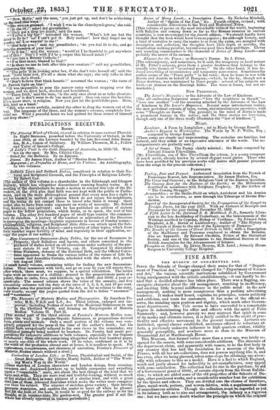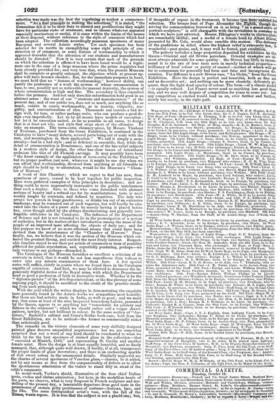FINE ARTS.
THE MUSEUM -07 ORNAMENTA.I. ART.
SINCE the Schools.,of Design changed their name for that of "Depart- ment of Practical .Art,"—now again changed for `.` Department of Science and Art," the various. scientific, institutions subsidized by Government being amalgamated with the artistic e,stablishinents,—it can hardly be de- nied that a decided,advatice has taken place. There was a flagging, un- energetic character about the Old manapinent, resulting in inefficiency, and exciting little- beyond indifference in the public mind : in the new management, nothing -is snore conspicuous than a pushing advertising. tendency. It makes itself heard, explains its principles, courts publicity and criticism, and touts for -customers. It has none of the official re- serve, the standing upon position and dignity, which mark other Govern-. went departments. Mr. Cole seems to have succeeded to a remarkable degree in indoctrinating his office and officers with the spirit of Felix Sumnaerly ; and, however gravely we may mistrust that spirit in some- of its modes and ultimate issues, it is fairly entitled to the credit of prac- ticality and effective movement in the present instance. Lectures are instituted, special classes established, assistance offered to voluntary ef- forts, a previously unknown influence in high quarters evident, vitality generally perceptible, and nowhere more so than in the Museum of Ornamental Art at Marlborough House. This Museum, first formed rather more than a year ago, was lately re- opened for the season, with some considerable additions. The directors of the department claim, and apparently with reason, to be the first body in any country that has laid the foundation for a museum of the kind. France, with all her art-collections, does not possess anything like it, and has even, after its being planned, taken some steps for obtaining one avow- edly with reference to this as a model. Here is a fact to which England, much and justly abused for imbecility in art-manufactures, may appeal with some satisfaction. The collection had rise in the purchase, by aid of a Government grant of 50001., of certain object' from the Great Exlaibi-' tion ; to which are added some of the old properties of the-Schools of De- sign, other purchased works, and a conaiderablentnnber lent for exhibition by the Queen and others. They are divided into the.elatios of furniture glass, metal-work; pottery, and woven fabrics,.; with Cauptalnnenta/ clan; of miscellaneous articles. Though the collectiOn,Inuttille.Meffatided Yot in its infancy bothnntOiaisa-a4dargaafrementk,# yIAone bat we-have-some doubt whether the *-00-1!"1. selection was made was the best kw 'regulating so modest a commence- ment. "As _first principle in 'making the selectionsy" it is stated, "the
Committee felt it to be their duty to discard any predilections they might
have for particular styles of ornament, and to ohooee whatever appeared especially meritorious or useful, if it came within the limits of the means
at their disposal, without reference to the style of ornament which had been adopted. The collection accordingly possesses specimens of many European and several Asiatic styles. Yet each specimen has been selected for its merits in exemplifying some right principle of con- struction or of ornament, or some feature of workmanship to which it appeared desirable that the attention of our students and manufacturers should be directed." Now it is very certain that each of the grounds on which the selection is affirmed to have been based would be a legiti- mate one in the case of a largo museum where the prime requisites had
been already provided for; and very true that, when the present Museum
shall be complete or greatly enlarged, the objection which at present ap- plies will have become obsolete. But, for the immediate purposes in hand, we must hold that no " feature of workmanship," however skilful, can justify the preference of a work the system of whose ornamentation is base, to one, possibly not so noticeable for manual dexterity, the system of whose ornamentation is high and fine. The secondary is thus consulted before the primary. And not only does this subordination hold good in an abstract sense : the want of our " students and manufacturers " of the
present day, and of our public too, does not so much, nor anything like so much, consist in coarse workmanship, as in inanity, vulgarity, stu- pidity, and conventionalism of idea. Thousands can execute a bad de- sign well, for tens, or rather perhaps units, who can produce a good de- sign even imperfectly. Let us by all means have models of execution ; but let it be execution united, as far as possible in all cases, to design that is at least not vile, and style that stops short of the offensive. To take an example. The terra-cotta chimney-piece, by Messrs. Virebent of Toulouse, purchased from the Great Exhibition, is confessed in the Catalogue to have "many defects, several parts being out of scale with the rest, and meaningless in their application." We call it simply a mon- strosity—bad in a bad style ; and so deficient in ensemble, that, while the detail of ornamentation is Renaissance, and one of the bas-relief subjects in a modern style of design, the other has clear traces of intentronal archaism like that of old Flemish carvings. It may possibly have been " the finest example of the application of terra-cotta in the Exhibition "; but its proper position just now, whatever it might be one day when we can afford that workmanship, divorced from anything at all tolerable in style should be held' up to admiration, would be the Museum's " Cham- ber of Horrors."
A word of this Chamber; • which we regret to find has now, from scantiness of space, ceased to be kept together for public inspection. Here were gathered examples of false principles in decoration ; and no- thing could be more impressively instructive to the public tastelessness than such a display. Save to those who come furnished with abstract notions of beauty and a refined eye for its manifestations, taste is most readily taught by contrasts, and defined by negatives. The lady who arrays her person in huge gaudinesses, or drinks tea out of an extensive landscape, may be reasoned Out of such vagaries, but will hardly be edu- cated into the choice of a purer style by merely having it placed before her, even though aided by the always discriminating and generally irre- fragable criticisms in the Catalogue. The influence of the Department of Science and Art is not intended to lie in the promulgation of a system of esthetics, but in the matter-of-fact introduction among the mass of the people of an improved taste affecting the objects of daily use ; and for this purpose we know of no more effectual means that could have been devised than the maintenance of the " Chamber of Horrors." Prac- tically, too, we believe that it was the section of the Museum which col- lected the greatest throng, and excited the most lively interest. Respect- able families stared to see their pet article of ornament or item of gentility gibbeted for public reprobation, and, regretfully pondering, perhaps—we only venture to say perhaps—discarded it.
The Catalogue of the Museum furnishes so excellent a criticism of its contents in detail, that it would be not less superfluous than tedious to enter into any minute examination of them here. A few special notes will suffice, chiefly in points where we found those in the Catalogue capable of extension. And first, we may be allowed to denounce the in- geniously frightful device of the Royal arms, with which the Department head so good a profession of faith in decorative truth. Whether it be the " diploma-picture" of the Art-Superintendent, or the fine phrensy of some aspiring pupil, it should be sacrificed to the credit of the practice result- zw from such principles.
With the zeal which the writer displays in demonstrating the exquisite taste generally found in the Asiatic works we sympathize most heartily. But there are bad articles made in India, as well as good ; and we must say, that some at least of the nine lacquered boxes from Lahore, presented by the Queen, appear to us anything but " remarkable for sobriety and fulness in the ornament"; which we should rather call a vulgar shawl- pattern, tawdry, but not brilliant in colour. In the same section of " fur- ' niture " Barbetti's cabinet and Crace's Gothic book-case, both from the Great Exhibition, are to be noticed—the former as commercially rather than artistically good.
The remarks on the vicious elements of some very skilfully designed painted glass deserve unqualified acquiescence : but we are somewhat surprised that not a word of any kind should be vouchsafed to what we think by far the best specimen of stained glass in the collection—that " executed at Munich, 1840," and representing St. Cecilia and another female saint. Here the design is at least equally beautiful, and so finely managed, that, although quite well drawn, it hardly, if at all, transgresses the proper limits of glass decoration ; and there is an enchanting sparkle of rich sweet colour in the ornamental details. Similarly neglected are the charms of several specimens of Venetian glass,—charms, be it added, not by any means so free from the companionship of defects as to allow the spontaneous admiration of the visitor to stand fitly in stead of the critic's comments.
In metal-work, Vechte's shield, illustrative of the four chief Italian poets, evokes and claims admiration ; but here, in the medallion heads of the poets, we observe, what is very frequent in French sculpture and mo- delling of the_present day, a lamentable departure from good taste in the pniminence of certain petty prettinesses of costume—buttons, lace and the hle. The same distinguished artist's vase, with the fall of the Titans, wants repose. It is true that the subject is not a placid ccie; but, if incapable of repose in the treatment, it behrelnelple faetcruhfitted for selection. The bronze bust of Pope Alexander the _Erghtli„ the* de. serving the commendation bestowed on it as being " in a grand style of portrait-sculpture," is still chargeable with the trivialities in costume to which we have just adverted. Messrs. Elkington's works in electro-plate are remarkably skilful ; and a medal of a female head by Albert Diirer, presented by Mr. Cole, would alone ennoble this section. The delicacy of the gradations in relief, where the highest relief is extremely low, is wonderful—past praise, and, it may well be feared, past, emulation. The pottery includes a large proportion deposited for exhibition by the Queen—Oriental and old Sevres porcelain. Oriental examples are 'al- most always admirable for some quality : the Sevres has little to Tecate- mend it to the eye of true taste save in merely technical properties— brilliancy of local colour or purity of enamel—neither of which will go far to compensate for generally bad form and false and incongruous de. coration. Far different is a new Sevres vase, "La Gloire," from the Great Exhibition. Here the design is perfect and beautiful, both as fine art and as decorative art ; and nothing can be more chastely, delicately pi. quant, than the light dead opacity of colour. The form—of a classic model —is equally refined. Let France never send us anything less good than this, and we may well despair of competition for years to come yet: but any competition so excited would lead us on, ever farther and farther, slowly but surely, in the right path.



























 Previous page
Previous page